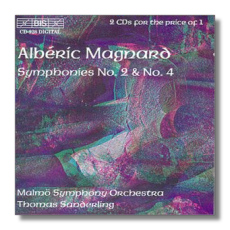
The Internet's Premier Classical Music Source
Related Links
- Latest Reviews
- More Reviews
-
By Composer
-
Collections
DVD & Blu-ray
Books
Concert Reviews
Articles/Interviews
Software
Audio
Search Amazon
Recommended Links
Site News
 CD Review
CD Review
Albéric Magnard

Symphonies #2 & 4
- Symphony #2 in E Major
- Symphony #4 in C Sharp minor
Malmö Symphony Orchestra/Thomas Sanderling
BIS CD-928 DDD 2CDs 41:55, 40:45
Composer Albéric Magnard is most famous for the manner in which he died: near the start of World War One, he was shot in his garden (or in his upstairs window – accounts differ) by renegade German soldiers, who then set fire to his house and all the musical manuscripts inside. He was not yet fifty. While alive, he enthused over Beethoven's music, and his early mentors included Massenet. The one composer who may have had the most influence on him was César Franck, through Vincent d'Indy, who taught Magnard between 1888 and 1892. There are moments in the symphonies that do sound very much like Franck, and other commentators have described him as a sort of Gallic Schumann. Whatever his influences were, there's little denying that his early music is fairly conservative. Only his late works take off in new directions, and the innovation has more to do with combination of older styles than with the invention of new ones. In the past twenty years, a resurgence of interest in Magnard's music has revealed him to be a composer of stature and skill, and the symphonies are certainly worth hearing from time to time.
To me, the Second Symphony often sounds like orchestrated organ music. Although the music has a serious personality, it is not morose. Some critics have commented that this symphony seems to evoke the Medieval era and chivalric deeds. That's not a bad description; there's an intriguing mixture of the courtly and the common here. The melodic invention, while not exactly memorable, is generous, and the harmonies and scoring are decidedly lush. The Fourth Symphony, completed almost twenty years later, shows some stylistic development. Magnard supposedly composed it in a state of intense depression, yet it isn't a bleak work either, in spite of its lack of frivolity. There's an undercurrent of unease that runs through the symphony, and also something of Tristan und Isolde, particularly in the third movement. Admirers of Franck and d'Indy will respond positively to this. These symphonies don't grab you at once, but they can be habit-forming.
Thomas Sanderling is the son of conductor Kurt Sanderling, who led the Leningrad Philharmonic Orchestra and made an early digital set of Beethoven symphonies that was sponsored by a tobacco company. I was pleased by Thomas Sanderling's recording of Mahler's Sixth Symphony several years ago, and it is a pleasure to report that he also responds well to the music of Albéric Magnard. Ideally, this music needs a Charles Munch, a Paul Paray, an Ernest Ansermet, or a Charles Dutoit. However, to the best of my knowledge, Ansermet was the only one of these four conductors to record any Magnard at all, and that CD is out of print, if it was ever available at all. (Michel Plasson's EMI set of the four symphonies also is out of print, but I was not excited by his interpretations.) There are fairly new recordings on the Hyperion label by Jean-Yves Ossonce and the BBC Scottish Symphony Orchestra, too. I haven't heard them, but they received good reviews from two Fanfare writers. At any rate, Sanderling and the Swedish orchestra are more than satisfactory, although I don't find them to be completely idiomatic.
These symphonies are just a little too long to fit on a single CD, so BIS has put them on separate discs, and is selling them two for the price of one – a good deal. The booklet notes by Julius Wender are well written, although I wish more had been said about the symphonies themselves. I am curious about the cover, which appears to be a three-dimensional photograph of who knows what. I don't have 3-D glasses, so I can't be sure.
Copyright © 2000, Raymond Tuttle


















